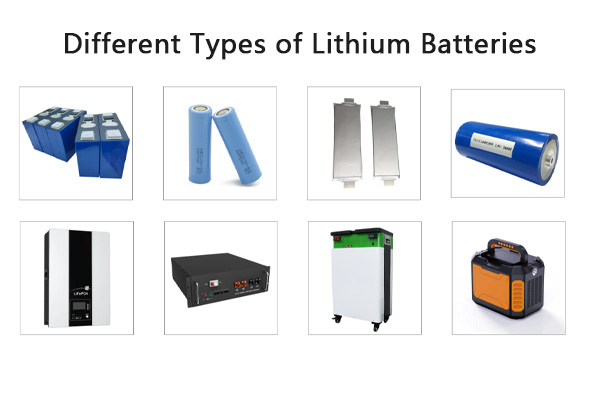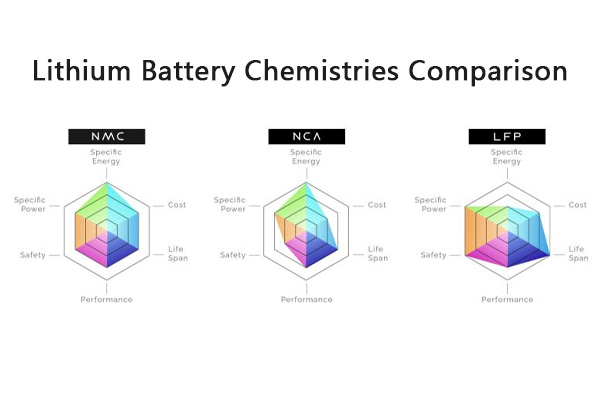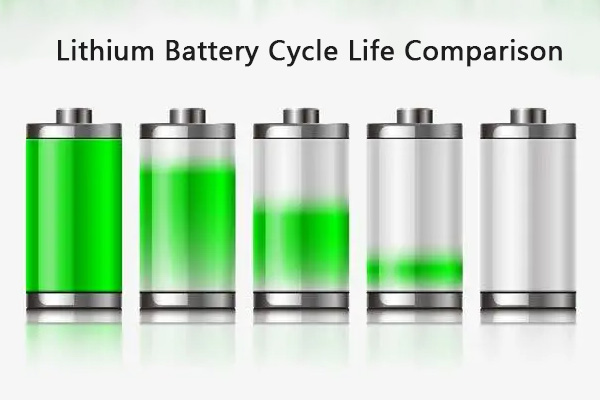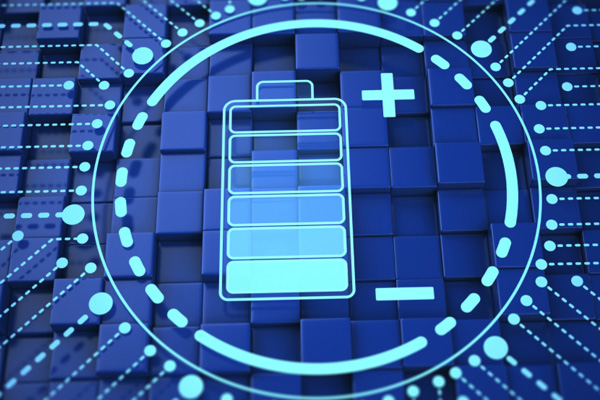리튬 배터리가 다릅니다?
모든 "리튬 배터리가 있는지 궁금합니다" 동일하게 생성됩니다? 이 용어가 포괄적인지 궁금 할 것입니다., 또는 중요한 차이가있는 경우. 다양한 리튬 배터리 세계를 분명히 할 것입니다..
예, 리튬 배터리에는 여러 가지가 있습니다, 각각 리튬 철 포스페이트와 같은 독특한 화학 (LFP), 리튬 니켈 망간 코발트 산화물 (NMC), 리튬 코발트 산화물 (LCO), 및 리튬 니켈 코발트 알루미늄 산화물 (NCA). 이러한 차이는 배터리의 성능을 지시하기 때문에 중요합니다., 안전 프로파일, 얼마나 오래 지속 될지, 그리고 GYCX Solar의 태양 에너지 저장 시스템에서 가장 잘 사용되는 것은, 포켓의 전기 자동차 및 스마트 폰에. 이러한 유형을 이해하는 것은 올바른 전원 솔루션을 선택하는 데 중요합니다..

리튬 배터리의 세계를 탐색하면 복잡해 보일 수 있습니다, 그러나 올바른 배터리 유형을 특정 요구에 맞추는 것입니다.. 주택 소유자 여부에 관계없이 주거용 태양열을 조사하고 있습니다, 상업 및 산업을 탐구하는 비즈니스 (씨&나) 에너지 저장, 유틸리티 규모 개발자, 또는 도매상, 기본 사항을 알면 더 똑똑한 투자를하는 데 도움이됩니다.. 몇 가지 일반적인 질문을 살펴 보겠습니다.
모두 리튬 배터리가 동일합니다?
리튬 배터리가 리튬 배터리라고 생각하십시오? 아마도 태양열 설정에 적극 권장되는 이유가 혼란 스러울 것입니다., Growatt 또는 Huawei Inverters와 짝을 이루는 것과 같습니다., 다른 장치는 완전히 다른 장치에서 발견됩니다. 모든 리튬 배터리가 동일한 내부 메이크업 또는 특성을 공유하는 것은 아닙니다..
아니요, 모든 리튬 배터리는 확실히 동일하지 않습니다. 그들은 화학 성분이 크게 다릅니다 - 음극에 사용되는 재료, 양극, 및 전해질. 일반적인 예는 LFP입니다 (리튬 철 포스페이트), NMC (리튬 니켈 망간 코발트 산화물), 그리고 LCO (리튬 코발트 산화물)1. 이러한 화학적 차이는 에너지 밀도 측면에서 매우 다른 특성으로 이어집니다. (크기/무게를 위해 얼마나 많은 에너지를 저장하는지), 사이클 수명 (몇 번이나 청구 및 배출을받을 수 있습니까?), 안전, 그리고 비용. 이것이 특정 유형이 특정 응용 프로그램에 더 적합한 이유입니다..

더 깊이 다이빙하십시오: 리튬 배터리 화학 이해
"유형" 리튬 배터리의 리튬 배터리는 주로 음극 재료로 정의됩니다.. 각 화학은 다른 트레이드 오프 세트를 제공합니다, 다른 작업에 적합하게 만듭니다. 예를 들어, 리튬 철 포스페이트 (LFP 또는 LIFEPO or) 배터리는 탁월한 안전성으로 유명합니다, 긴 사이클 수명, 열 안정성. 이것은 고정 에너지 저장을위한 환상적인 선택입니다., 가정 및 사업을위한 태양 광 발전 시스템과 같은, 우리가 GYCX Solar에서 제공하는 것의 핵심 부분입니다.. 다른 유형에 비해 에너지 밀도가 약간 낮을 수 있습니다., 그러나 장수와 안전이 가장 중요합니다, 그들은 종종 우수한 선택입니다. 우리는 고객의 태양열 설치에서 LFP 배터리가 얼마나 잘 작동하는지 직접 보았습니다., 해마다 신뢰할 수있는 전력을 제공합니다.
그런 다음 있습니다 리튬 니켈 망간 코발트 산화물 (NMC). 이 배터리는 더 높은 에너지 밀도를 제공합니다, 더 작은 에너지를 더 작은에 저장할 수 있음을 의미합니다, 가벼운 패키지. 이것은 전기 자동차에서 인기를 얻습니다 (EV) 전동 공구, 공간과 무게가 중요한 곳. 하지만, 그들은 일반적으로 사이클 수명이 짧으며 정교한 배터리 관리 시스템에 의해 조심스럽게 관리되지 않으면 열 런 어웨이에 더 취약 할 수 있습니다. (비엠에스). 리튬 코발트 산화물 (LCO) 배터리는 특정 에너지가 매우 높으며 작은 장치에서 런타임을 최대화하는 스마트 폰 및 랩톱과 같은 휴대용 전자 제품에서 일반적으로 발견됩니다..
그들의 수명과 안전은 LFP 또는 NMC만큼 강력하지 않습니다., 그렇기 때문에 일반적으로 대규모 에너지 저장 또는 자동차 응용 프로그램에서 보지 못하는 이유입니다.. 다른 유형 리튬 니켈 코발트 알루미늄 산화물 (NCA) NMC와 유사하며 일부 EV에서도 사용됩니다., ~하는 동안 리튬 망간 산화물 (LMO) 그리고 리튬 티탄 (LTO) 높은 방전 속도와 같은 특정 강점이나 다른 특성을 희생하여 매우 긴 사이클 수명과 같은 특정 강점으로 인해 자체 틈새 응용 프로그램이 있습니다.. 보시다시피, 매우 다양한 풍경입니다!
어떤 유형의 리튬 배터리가 가장 좋습니다?
단일 "Best를 검색합니다" 리튬 배터리 유형은 약간의 오해의 소지가있는 퀘스트 일 수 있습니다.. 당신은 어떤 화학이 당신의 에너지 요구에 최적인지 확실하지 않을 것입니다., 특히 많은 옵션이 있습니다. 이상적인 선택은 실제로 특정 응용 프로그램과 우선 순위에 크게 의존합니다..
"최고"는 없습니다" 전반적으로 리튬 배터리의 유형; 실제로 응용 프로그램에 따라 다릅니다. 태양 에너지 저장 용, Gycx Solar에서 우리에게 핵심 초점, 리튬 철 포스페이트 (LFP) 배터리는 종종 우수한 안전성으로 인해 최고로 간주됩니다., 긴 사이클 수명, 수명 동안의 비용 효율성. 전기 자동차의 경우, NMC 또는 NCA 화학은 종종 더 높은 에너지 밀도에 선호됩니다., 더 긴 운전 범위를 허용합니다. LCO는 작은 크기와 높은 초기 전력 인 휴대용 소비자 전자 제품에서 일반적입니다..

더 깊이 다이빙하십시오: 배터리를 미션과 일치시킵니다
"최고" 배터리는 특정 작업의 요구 사항을 가장 잘 충족시키는 배터리입니다.. 을 위한 고정 에너지 저장 시스템, 주거용 태양 전지판과 짝을 이루는 것과 같은, 씨&나, 또는 유틸리티 규모 프로젝트, LFP 배터리가 빛납니다. 그들의 주요 장점은 탁월한 안전입니다 (열 런 어웨이가 덜 발생합니다), 매우 긴 사이클 수명 (수천 개의 전하 차지 사이클), 다양한 온도에 걸쳐 우수한 열 안정성, 그리고 운영 수명 동안 점점 더 매력적인 비용.
Gycx Solar에서, 이러한 이유로 LFP 화학을 자주 권장합니다, 고객이 신뢰할 수 있고 내구성있는 스토리지 솔루션을 얻도록. 이 배터리는 Growatt 및 Huawei와 같은 주요 인버터 브랜드와 완벽하게 통합됩니다., 효율적이고 강력한 태양 에너지 시스템 생성.
을 위한 전기 자동차 (EV), 전자 자전거, 드론, 고성능 전동 공구, 우선 순위는 종종 더 높은 에너지 밀도로 이동합니다. NMC와 NCA 화학이 들어오는 곳입니다. 더 작고 가벼운 배터리에 더 많은 에너지를 포장 할 수 있습니다., 모바일 애플리케이션에서 범위 또는 전력 출력을 최대화하는 데 중요한. 사이클 수명과 열 안정성은 LFP와 일치하지 않을 수 있습니다., 배터리 관리 시스템의 발전 (비엠에스) 안전하고 효율적으로 작동하는지 확인하십시오.
을 위한 작은, 휴대용 소비자 전자 제품 스마트 폰처럼, 정제, 그리고 노트북, 리튬 코발트 산화물 (LCO) 역사적으로 매우 높은 특정 에너지로 인해 인기있는 선택이었습니다., 슬림 한 디자인을 허용합니다. 하지만, 여기서 강조는 초기 용량에 더 가깝고 극한 사이클 수명 또는 더 큰 시스템에 필요한 강력한 안전성에 대한 강조가 더 적습니다..
열쇠는 이러한 상충 관계를 이해하는 것입니다: 에너지 밀도를 우선시하고 있습니까?, 안전, 수명, 비용, 또는 이들의 특정 균형? 신뢰할 수있는 GYCX Solar의 대부분의 고객을 위해, 장기 태양 에너지 저장, LFP가 지속적으로 맨 위에 나옵니다.
리튬 배터리가 가장 오래 지속됩니다?
배터리 투자가 거리를 가고 수년 동안 가치를 제공하기를 원합니다.? 빈번한 교체의 전망 및 총 소유 비용에 대해 우려? 장수, 사이클 수명과 달력 수명 측면에서, 리튬 배터리 유형에 따라 크게 다릅니다.
일반적으로, 리튬 철 포스페이트 (LFP 또는 LIFEPO or) 배터리는 가장 오래 지속됩니다. 그들은 일반적으로 매우 높은 사이클 수명을 제공합니다, 종종 어디서나 인용됩니다 3,000 에게 6,000 사이클, 그리고 일부 고품질 LFP 세포는 심지어 초과 할 수 있습니다 10,000 최적의 조건에서 사이클. 그들은 또한 좋은 달력 수명을 보여줍니다 (사용에 관계없이 얼마나 오래 지속되는지). 이로 인해 배터리가 매일 순환되고 10 년 이상 안정적으로 수행 될 것으로 예상되는 태양 에너지 저장과 같은 응용 프로그램에 이상적입니다..

더 깊이 다이빙하십시오: LFP의 수명 뒤에있는 과학
LFP 배터리의 인상적인 수명은 화학 및 구조적 안정성에서 직접 비롯됩니다.. LFP 세포의 포스페이트 기반 캐소드 물질은 LCO 또는 NMC 배터리에서 발견되는 코발트 또는 니켈 기반 음극보다 본질적으로 더 안정적입니다..
이 안정성은 LFP 배터리가 배터리 수명을 단축시키는 일반적인 저하 메커니즘에 덜 취약하다는 것을 의미합니다., 활성 재료 손실 또는 시간이 지남에 따라 내부 저항 증가와 같은. 그들은 특히 열 응력에 대해 강력합니다; 철 포스페이트 결합은 더 강합니다, 더 높은 온도에서 재료를 분해 할 가능성이 적습니다., 열 런 어웨이의 위험을 줄이고 더 오래 기여합니다., 더 안전한 운영 생활. 뿐만 아니라, LFP 배터리는 일반적으로 더 깊이 배출 될 수 있습니다 (더 높은 배출 심도, 또는 Dod) 다른 리튬 화학에 비해 전체 수명에 상당한 피해를 입지 않음.
모든 배터리는 결국 저하됩니다, LFP의 화학 메이크업은 단순히 반복적 인 충전 및 배출의 엄격함을 더 잘 견뎌냅니다.. 이것이 이유입니다, 수천주기가 필요한 응용 프로그램의 경우 - 낮에는 태양에서 충전하고 밤에는 퇴원하는 일일 태양 에너지 저장과 같이 - LFP는 챔피언입니다.. 주기 수가 아닙니다; 또한 해당주기를 통해 원래 용량의 높은 비율을 유지하는 것입니다., 지속적인 성능 보장. 그렇기 때문에 GYCX Solar의 우리는 고객의 장기 에너지 저장 요구에 대한 LFP 기술에 대한 확신을 가지고 있습니다..
리튬보다 더 나은 배터리가 있습니까??
리튬 이온 기술이 최고의 배터리 솔루션인지 궁금합니다, 또는 특정 작업에 대해 성능이 우수 할 수있는 다른 경쟁자가있는 경우? 대안에 대해 궁금한 것은 당연합니다, 특히 기술이 발전함에 따라. 리튬 이온은 많은 지역에서 현재 리더입니다, "더 나은" 선택은 항상 특정 요구에 달려 있습니다, 그리고 새로운 혁신은 끊임없이 떠오르고 있습니다.
광범위한 최신 응용 분야, 특히 높은 에너지 밀도, 좋은 사이클 생활, 비교적 가벼운 무게가 중요합니다, 리튬 이온 배터리는 현재 최고의 성능 균형을 제공합니다., 수명, 비용 절감.
하지만, 다른 배터리 기술이 존재하며 "더 나을 수 있습니다" 매우 구체적인 사용 사례. 예를 들어, 전통적인 납산 배터리 (어떤 GYCX 태양도 공급합니다) 특정 예산 의식에 적합 할 수 있습니다, 로우 사이클 백업 응용 프로그램. 나트륨 이온 및 솔리드 스테이트 배터리와 같은 차세대 기술에 대한 흥미로운 연구가 진행 중입니다., 미래에 대한 약속을 지니고 있습니다.

더 깊이 다이빙하십시오: 리튬 이온 너머의 배터리 조경 탐색
리튬 이온 배터리 중, 특히 태양 저장 용 LFP, 지금은 환상적이고 종종 최적의 선택입니다, 배터리 세계가 역동적이라는 것은 사실입니다. 몇 가지 대안을 고려해 봅시다. 납산 배터리, 훨씬 오래된 기술, 일부 상황에서는 여전히 관련이 있습니다. 그들은 선불 비용이 낮고 잘 이해되고 있습니다.
GYCX Solar의 우리는 특정 응용 프로그램을위한 실용적인 솔루션이 될 수 있기 때문에 제공합니다., 무정전 전원 공급 장치처럼 (UPS) 배출주기가 드물게있는 곳, 또는 특정 오프 그리드 시스템에 대한 초기 예산 제약이 매우 엄격한 고객의 경우. 하지만, 그들은 훨씬 무겁습니다, 사이클 수명이 훨씬 짧습니다, 사용 가능한 용량이 낮습니다 (방전 깊이), 리튬 이온에 비해 더 많은 유지 보수가 필요합니다.
미래를 바라보고 있습니다, 나트륨 이온 (N- 이온) 배터리 많은 관심을 받고 있습니다. 나트륨은 풍부하고 저렴합니다, 배터리 비용이 낮아질 수 있습니다. 또한 리튬 이온과 일부 운영 유사성을 공유하며 안전 특성이 우수합니다.. 그들의 에너지 밀도는 현재 대부분의 리튬 이온 유형보다 낮습니다., 그들은 공간이 주요 제약 조건이 아닌 고정 저장의 경쟁자가되고 있습니다.. 우리는 대규모 응용 프로그램의 개발을 계속 주시하고 있습니다..
솔리드 스테이트 배터리 또 다른 흥미로운 프론티어입니다. 기존의 리튬 이온 배터리에서 발견되는 액체 전해질을 고체 재료로 교체합니다.. 이것은 더 높은 에너지 밀도로 이어질 수 있습니다, 안전성 향상 (액체 전해질은 가연성 일 수 있습니다), 그리고 잠재적으로 더 긴 수명. 주요 연구 개발 노력이 진행 중입니다, 그리고 일부 틈새 응용 프로그램이 떠오르고 있습니다, 일반적인 사용을위한 광범위한 상업용 가용성, 태양 저장을 포함하여, 여전히 몇 년이 지났습니다.
지금은, 리튬 이온 기술, 특히 안전 균형을위한 LFP, 장수, 태양 광 응용 분야의 성능, 대부분의 고객의 요구에 가장 성숙하고 효과적인 솔루션을 나타냅니다. Gycx 솔라). 그러나 혁신은 결코 멈추지 않습니다, 그리고 우리는 최고의 기술을 진화 할 때 최고의 기술을 제공하기 위해 노력하고 있습니다..
이 개요가 모든 리튬 배터리가 동일하다는 것을 이해하는 데 도움이되기를 바랍니다., 그리고 "최고" 선택은 매우 응용 프로그램에 따라 다릅니다. Gycx Solar에서, 우리는 고품질 리튬 배터리를 제공하는 데 특수합니다, 특히 LFP, 태양 에너지 저장 솔루션에 맞게 조정되었습니다, 특정 요구에 대한 안정적인 리드산 옵션과 함께.
집에 적합한 배터리 유형에 대해 궁금한 점이 있으면, 사업, 또는 프로젝트, 또는 Growatt 또는 Huawei와 같은 브랜드의 인버터와 배터리 통합에 대해 논의하려면, 주저하지 말고 연락하십시오. 우리 팀은 완벽한 에너지 저장 솔루션을 찾도록 도와 줄 준비가되었습니다.. 오늘 GYCX Solar와의 문의를 시작하십시오!
리튬 배터리 제품을 더 잘 선택할 수 있도록 LCO 배터리에 대해 알아보십시오.. ↩
